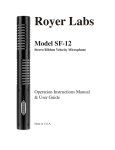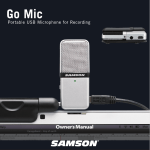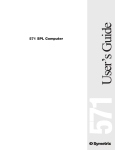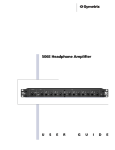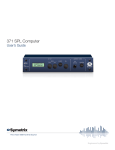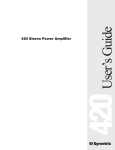Download Symetrix 450-manual
Transcript
User’s Guide 450 450 Dual Zone Priority Mixer Table of Contents 1 Chapter 2 Operator Safety Summary 2 Chapter 3 Fast Setup 3 Chapter 4 Mic/Line Inputs 4 Chapter 5 Stereo Line Inputs 6 Chapter 6 Output Zone Master 7 Chapter 7 Priority Override Muting 9 Chapter 8 Applications 10 Chapter 9 Troubleshooting 12 Chapter 10 Specifications 13 Chapter 11 Warranty & Service 14 Appendix A Input/Output Connections 16 Appendix B Declaration of Conformity 17 450 Chapter 1 Introduction Rev C.00, 6 July, 1999 Symetrix part number 53450-0C00 Subject to change without notice. ©1999, Symetrix, Inc. All right reserved. Symetrix is a registered trademark of Symetrix, Inc. Mention of third-party products is for informational purposes only and constitutes neither an endorsement nor a recommendation. Symetrix assumes no responsibility with regard to the performance or use of these products. Under copyright laws, no part of this manual may be reproduced or transmitted in any form or by any means, electronic or mechanical, including photocopying, scanning, recording or by any information storage and retrieval system, without permission, in writing, from Symetrix, Inc. i 14926 35th Ave. West Lynnwood, WA 98037 USA Tel (425) 787-3222 Fax (425) 787-3211 Email [email protected] Chapter 1 Introduction The 450 Dual Zone Priority Mixer is designed for paging and music sound systems in clubs, restaurants, hotels, conference facilities, houses of worship or anywhere multiple audio inputs must be combined and distributed. There are two mono mic/line inputs (with phantom power and low frequency filters) and four stereo line inputs. Each input may be assigned to a stereo output zone, a mono output zone or both. Our unique hierarchical Priority Override structure permits the two mic/line inputs and the first stereo line input to mute the other (lower priority) inputs assigned to the same zone. For example, in a typical configuration, a paging microphone assigned to the stereo zone will have priority over a background music source (connected to line input 5-6) in that zone. A jukebox (connected to line input 3-4) in the same zone will have priority over the background music, but the paging signal will retain ultimate priority and force muting of both the jukebox and the background music whenever the page mic is used. The 450’s flexibility and simplicity make it the perfect choice for a wide variety of systems. By accepting audio inputs from virtually any type of audio source and selectively routing to either the mono or stereo output zone the 450 can save you time and money in the design and installation of your next project. Of course we recommend you read this manual cover-to-cover. You’ll find the answer to most of your questions inside. If you have technical questions beyond the scope of this manual contact our Customer Service Department at: Phone: (425) 787-3222 Fax: (425) 787-3211 Email: [email protected] MIC/LINE IN 1 (PRIORITY 1) MIC/LINE IN 2 (PRIORITY 2) GAIN ZONE ASSIGN 450 LINE IN 3-4 (PRIORITY 3) GAIN ZONE ASSIGN U DUAL ZONE PRIORITY MIXER ZONE ASSIGN GAIN U ZONE 1 LINE IN 5-6 ZONE 1 LINE IN 7-8 GAIN ZONE ASSIGN U ZONE 1 LINE IN 9-10 GAIN ZONE ASSIGN U ZONE ASSIGN ZONE 1 ZONE 1 OUT (MONO) GAIN U U ZONE 1 PRIORITY OVERRIDE ZONE 1 ZONE 2 OUT (STEREO) MASTER L U +15 0 ZONE 2 HIGH PASS ∞ ZONE 2 HIGH PASS ∞ +15dB ZONE 2 ∞ +15dB ZONE 2 ∞ +15dB ∞ ZONE 2 +15dB ZONE 2 ∞ +15dB PRIORITY OVERRIDE MASTER U 0 -15 +15dB R +15 POWER -15 LOW -30 BYPASS ∞ +15dB LOW -30 BYPASS ∞ +15dB OUTPUTS 450 DUAL ZONE PRIORITY MIXER THIS UNIT CONTAINS NO USER SERVICABLE PARTS. CONNECT TO SYMETRIX PS-3 OR PS-3E POWER SUPPLY ONLY. MANUFACTURED IN LYNNWOOD, WA, USA REMOTE CONTROL ZONE 2 (STEREO) LINE IN 9-10 ZONE 1 (MONO) LINE IN 7-8 (MONO) LINE IN 5-6 (MONO) LINE IN 3-4 (PRIORITY 3) (MONO) (MONO) MIC/LINE IN 2 (PRIORITY 2) MIC/LINE IN 1 (PRIORITY 1) MIC PAD MIC PAD OUT IN MIC LINE ZONE 2 ZONE 1 RIGHT LEFT RIGHT LEFT RIGHT LEFT RIGHT LEFT RIGHT LEFT 450 Front panel INPUT SELECT OUT IN MIC LINE INPUT SELECT Rear panel 1 Operator Safety Summary Equipment Markings CAUTION RISK OF ELECTRIC SHOCK DO NOT OPEN TO REDUCE THE RISK OF FIRE OR SHOCK DO NOT EXPOSE WARNING: ELECTRIC THIS EQUIPMENT TO RAIN OR MOISTURE DE CHOC ELECTRIQUE AVIS: RISQUE NE PAS OUVRIR SEE OWNERS MANUAL. VOIR CAHIER D’INSTRUCTIONS. No user serviceable parts inside. Refer servicing to qualified service personnel. Il ne se trouve a l’interieur aucune piece pourvant entre reparée l’usager. S’adresser a un reparateur compétent. The lightning flash with arrowhead symbol within an equilateral triangle is intended to alert the user of the presence of uninsulated “dangerous voltage” within the product’s enclosure that may be of sufficient magnitude to constitute a risk of electric shock to persons. The exclamation point within an equilateral triangle is intended to alert the user of the presence of important operating and maintenance (servicing) instructions in the literature accompanying the product (i.e. this manual). Caution To prevent electric shock, do not use the polarized plug supplied with the unit with any extension cord, receptacle, or other outlet unless the blades can be fully inserted. Terms Several notational conventions are used in this manual. Some paragraphs may use Note, Caution, or Warning as a heading. Certain typefaces and capitalization are used to identify certain words. These are: 450 Note Caution Warning CAPITALS Boldface Identifies information that needs extra emphasis. A Note generally supplies extra information to help you to better use the 450. Identifies information that, if not heeded, may cause damage to the 450 or other equipment in your system. Identifies information that, if ignored, may be hazardous to your health or that of others. Controls, switches or other markings on the 450’s chassis. Strong emphasis. Important Safety Instructions Please read and keep these instructions. Heed and follow all warnings and instructions. Install in accordance with the manufacturer’s instructions. Power Source This product is intended to operate from a power source that does not apply more than 250V rms between the power supply conductors or between either power supply conductor and ground. A protective ground 2 Chapter 2 connection, by way of the grounding conductor in the power cord, is essential for safe operation. Grounding The chassis of this product is grounded through the grounding conductor of the power cord. To avoid electric shock, plug the power cord into a properly wired receptacle before making any connections to the product. A protective ground connection, by way of the grounding conductor in the power cord, is essential for safe operation. Do not defeat the safety purpose of the grounding plug. The grounding plug has two blades and a third grounding prong. The third prong is provided for your safety. When the provided plug does not fit your outlet, consult an electrician for replacement of the obsolete outlet. Danger from Loss of Ground If the protective ground connection is lost, all accessible conductive parts, including knobs and controls that may appear to be insulated, can render an electric shock. Proper Power Cord Use only the power cord and connector specified for the product and your operating locale. Use only a cord that is in good condition. Protect the power cord from being walked on or pinched, particularly at plugs, convenience receptacles, and the point where they exit from the apparatus. Operating Location Do not operate this equipment under any of the following conditions: explosive atmospheres, in wet locations, in inclement weather, improper or unknown AC mains voltage, or if improperly fused. Do not install near any heat source such as radiators, heat registers, stoves, or other apparatus (including amplifiers) that produce heat. Unplug this apparatus during lightning storms or when unused for long periods of time. Stay Out of the Box To avoid personal injury (or worse), do not remove the product covers or panels. Do not operate the product without the covers and panels properly installed. Only use accessories specified by the manufacturer. Clean only with a damp cloth. User-serviceable parts There are no user serviceable parts inside the 450. In case of failure, refer all servicing to the factory. Servicing is required when the 450 has been damaged in any way, such as when a power supply cord or plug is damaged, liquid has been spilled or objects have fallen into the apparatus, the apparatus has been exposed to rain or moisture, does not operate normally, or has been dropped. Chapter 3 Fast Setup If you’re in a hurry to get the 450 into your sound system and don’t have time to thoroughly read this manual, the following steps will probably be enough to get you started: n Turn all front panel gain controls down. sure all Zone Assign buttons are o Make OUT. p Connect the 450 to AC power. all back panel switches in correct q Set position. Take extra care to set the Mic/ Line switch (found on Inputs 1 and 2 only) in the appropriate position. all the audio inputs and outputs r Connect you need. BOTH Priority Override adjusts Set ments to BYPASS. To use this feature, see Priority Override Muting in the Operations section of this manual. the inputs to appropriate zones, t Assign set the Zone Out Master to 12:00 (unity gain), and turn up each input until the sound source is at the desired loudness. 450 u Now read the rest of this manual. 3 Mic/Line Inputs Chapter 4 Front Panel MIC/LINE IN 1 (PRIORITY 1) MIC/LINE IN 2 (PRIORITY 2) GAIN ZONE ASSIGN GAIN ZONE ASSIGN U ZON U ZONE 1 ZONE 1 R ZONE 2 HIGH PASS ∞ +15dB ZONE 2 HIGH PASS ∞ +15dB Zone Assign - Any input can be assigned to either the mono or stereo output zone, or both, or neither. When either Mic/Line input is assigned to the stereo output zone, both left and right will be driven by the same signal. For the best signal to noise performance, leave the input unassigned if not in use. Highpass Filter - 12dB/Oct LF rolloff. 3dB down at 115 hz. Use this to eliminate excessive “ppopping” or room rumble from paging/announce mics. Even if you don’t notice a problem, try pushing this switch anyway. It increases the efficiency of systems using ceiling mounted speakers of the 70V variety, because it removes low frequency material that the speakers probably can’t reproduce anyway. It will help your amplifier to run cooler, draw less power, and just maybe it will help to extend the life of the speaker. 450 Channel Gain Control - Gain range is -∞ to +15dB. Unity gain (indicated by the “u” symbol on the front panel) at 12:00 position. This is no ordinary volume control. Well, actually it is. 4 Rear Panel MIC/LINE IN 2 (PRIORITY 2) MIC/LINE IN 1 (PRIORITY 1) MIC PAD MIC PAD OUT IN OUT IN MIC LINE MIC LINE INPUT SELECT INPUT SELECT XLR Input Jack - In order to fit all the inputs and outputs onto the 450’s rear panel, we combined the Mic/Line Input jacks into one balanced XLR connector that can handle both. This jack is wired as follows: Pin 1 = (ground, shield) Pin 2 = (high, +) Pin 3 = (low, -) Most low impedance, balanced microphones (and many line level sources) can plug directly into these jacks, but some sources will require adapters. See the chart in Appendix A for examples. Caution Do not attempt to connect a high impedance, unbalanced micro- phone (these usually, but not always, have a 1/4" phone jack attached to them) to either Mic/Line input unless you first disconnect the phantom power. INPUT SELECT Switch - Push this switch in to accommodate line level sources such as PBX paging outputs, mixing consoles, automated emergency announce systems, etc. This bypasses the mic preamp circuit and disconnects phantom power from the XLR connector. Note Make sure the Mic/Line input is not assigned to either Zone Output when you push the Mic/Line switch because the phantom power may cause a slight pop. In the mic (out) position, the input signal is routed through the mic preamp and the phantom power is engaged. The preamp stage delivers approximately 40 dB of gain. Do not put this switch into the Mic position when feeding a line level signal into this input (unless you enjoy re-coning speakers). 450 Warning MIC PAD Switch - This decreases the gain of the mic preamp by 20 dB. Engage this switch if the mic level signal source tends to overload the input preamp stage, or you notice that the incoming signal is so hot that you have to run the Channel Gain knob really low. Typically, this happens when using high output condenser mics, or handheld, close-talked mics. As the name Mic Pad suggests, this switch does not affect the input gain when the channel is operating in Line mode. Phantom Power- Phantom power is applied to the Mic/Line input only when the mic/line switch is in the mic (in) position. If you want to completely disconnect the phantom power, please contact Symetrix Customer Service. 5 Stereo Line Inputs Chapter 5 Front Panel LINE IN 3-4 (PRIORITY 3) LINE IN 5-6 GAIN ZONE ASSIGN ZONE ASSIGN LINE IN 7-8 GAIN U U ZONE 1 LINE IN 9-10 GAIN ZONE ASSIGN ZONE ASSIGN GAIN U ZONE 1 U ZONE 1 +1 ZONE 1 -1 ∞ ZONE 2 +15dB ∞ ZONE 2 +15dB ZONE 2 ∞ +15dB ZONE 2 ∞ +15dB -3 Zone Assign - As you might expect, the Left and Right input signals are summed when fed to the Zone 1 (mono) output. This is done independently of the Zone 2 (Stereo) feed, which keeps the signals separate. As with the Mic/Line inputs, maximize the unit’s signal-to-noise ratio by leaving all unused inputs unassigned. Channel Gain - The wide gain range of this control (-∞ to +15dB) accommodates the variety of input levels generically known as “line level”, including tape decks, CD players, console feeds, etc. Unity gain is indicated by the “u” symbol on the front panel. Rear Panel LINE IN 9-10 E1 O) (MONO) RIGHT 450 LINE IN 7-8 LEFT LINE IN 5-6 (MONO) RIGHT LEFT LINE IN 3-4 (PRIORITY 3) (MONO) RIGHT LEFT (MONO) RIGHT LEFT Input Jacks - Line inputs 3-6 are equipped with 1/4", TRS (tip-ring-sleeve), balanced, phone jacks. They are wired as follows: Tip = (high, +) Ring = (low, -) Sleeve = (ground, shield) Line inputs 7-10 are unbalanced RCA-phono type jacks. They are wired as follows: Tip = (high, +) Sleeve = (ground, shield) Though you’ll be able to plug most line level outputs directly into the 450, some sources may need adapters. See Appendix A for proper wiring. Mono/Stereo Operation - Line Inputs 3-10 are arranged in stereo pairs; each pair is assigned to a single gain control on the front panel. If you want to use one of these inputs with a mono source, just insert a single plug into the jack labeled Left (mono) and leave the Right jack unconnected. The left jack will automatically feed both the left and right channels of the Zone 2 (stereo) output. 6 Chapter 6 Output Zone Master Front Panel ZONE 1 OUT (MONO) PRIORITY OVERRIDE ZONE 2 OUT (STEREO) MASTER L U +15 PRIORITY OVERRIDE MASTER U +15 0 0 -15 -30 R POWER -15 LOW BYPASS ∞ +15dB -30 LOW BYPASS ∞ +15dB Output Jacks - The 450’s outputs are electronically balanced, low-impedance, and capable of driving a balanced input to +22dBu. The output connectors are 1/4" Tip-Ring-Sleeve and you can find wiring and adapter examples in Appendix A. Master Gain Controls These controls have the same gain range as the input channel gain controls -∞ to +15dB. The “u” symbol at the knob’s 12:00 position indicates unity gain when the 450’s output is driving a balanced input. The 450 uses a differential output driver that drops the output level by 6db when connected to an unbalanced input. This does not adversely affect the audio quality whatsoever and is easily fixed by increasing the output gain knob setting by 6dB. Rear Panel OUTPUTS REMOTE CONTROL ZONE 2 ZONE 1 ZONE 2 (STEREO) RIGHT ZONE 1 (MONO) LEFT Remote Control - There are two ways to externally control the volume of the 450’s Zone Outputs. Both options render the front panel master gain control inactive. Option #1 - The easiest method is the old volume-knob-in-a-wall-plate. Use a 50k linear potentiometer and wire it as follows on the next page in diagrams 1 or 2. The remote control cable is not carrying any audio signal, just DC control voltage. This means that you can use a very long cable (up to 1000') without degrading the 450’s performance whatsoever. To achieve this, you must use 20-22 gauge, three conductor plus ground cable and wire it according to diagram 2. Option #2 - If you’re using a programmable remote control system that has the ability to supply an external voltage to the 450, no problemo. Wire it as seen in Diagrams 3 or 4 on the following page. The dB/Voltage gain scale is 5dB/V, Unity gain = 11.5V. Note that the +15V control voltage supplied by the 450 (on the tip of the TRS connector) is not used in this configuration. This is okay, it won’t hurt anything. In fact, you can save a little money on your remote cable by using one conductor plus ground for short cable runs (see diagram 3) or two conductor plus ground for long runs (see diagram 4). 7 450 AL ZONE PRIORITY MIXER Remote Control Wiring Diagram 1 50K LINEAR POTENTIOMETER TIP OPTIONAL 6K04 RESISTOR RING SLEEVE Diagram 2 FOR LONG DISTANCE OR NOISY ENVIRONMENTS (OVER 100 FEET) 50K LINEAR POTENTIOMETER TIP 3 CONDUCTOR WITH SHIELD SHIELD CONNECTED AT PLUG END ONLY RING SLEEVE OPTIONAL 6K04 RESISTOR Diagram 3 RING TO VOLTAGE SOURCE 450 TIP NOT CONNECTED SLEEVE TO GROUND RING SLEEVE Diagram 4 FOR LONG DISTANCE OR NOISY ENVIRONMENTS (OVER 100 FEET) TIP NOT CONNECTED 2 CONDUCTOR WITH SHIELD RING SLEEVE 8 RING TO VOLTAGE SOURCE SLEEVE TO GROUND Chapter 7 Priority Override Muting Priority Levels - The term “priority override” refers to the 450’s ability to selectively mute it’s “low priority” inputs when audio signal is present on it’s “high priority” inputs. There are actually four different levels of priority, assigned as follows: Input Mic/Line In 1 Mic/Line In 2 Line In 3-4 Line In 5-6, 7-8, 9-10 Priority Level Priority One (highest) Priority Two (not so high) Priority Three (even lower) No priority When audio is detected on a Priority input, all inputs with a lower Priority Level will mute until audio is no longer detected on the higher Priority Level input (see the diagram below). It’s important to note that the Priority Override Muting function is directly linked to an input’s zone assignment. Priority Override Adjustment - This control is the trim adjustment found next to each Zone Out Master level control on the 450’s front panel (see the front panel drawing on page 7). It varies the trigger threshold of the Priority Override muting function. i.e. The muting function activates when the audio level on a Priority channel exceeds this setting. To disable the Override function for either Zone Out, set the trim control to the Bypass position. Note We recommend that you set the trigger threshold as low as possible if you are using one music source to mute another. An example of this is a restaurant/bar system that uses a CD jukebox to automatically mute the TV/video feed. A low threshold will prevent the “low priority input” from un-muting during quiet musical passages. Note In a paging system with a live (i.e. no on/off switches) paging mic, you may want to set the trigger threshold higher to prevent background noise from activating the muting function. MIC/ LINE 2 LINE 3/4 LINE 5/6 LINE 7/8 LINE 9/10 MUTING LOGIC PRIORITY 1 ZONE 1 ASSIGN PRIORITY 2 ZONE 1 ASSIGN ZONE 1 PRIORITY 3 ZONE 1 ASSIGN NO PRIORITY ZONE 1 ASSIGN ZONE 1 ASSIGN ZONE 1 ASSIGN (MONO) PRIORITY OVERRIDE MUTING LOGIC PRIORITY 1 ZONE 2 ASSIGN PRIORITY 2 ZONE 2 ZONE 2 ASSIGN PRIORITY 3 ZONE 2 ASSIGN NO PRIORITY ZONE 2 ASSIGN (STEREO) PRIORITY OVERRIDE ZONE 2 ASSIGN ZONE 2 ASSIGN 9 450 MIC/ LINE 1 Applications Chapter 8 Two Zone Foreground Music with Paging The following is a layout of a typical restaurant/bar combination system. When someone makes an announcement, the announce audio goes only to Zone 2 which we have drawn as a stereo sound system in the bar area. The 450 mutes only the foreground music’s feed to that zone, leaving the Zone 1 (the dining room) music feed live. It’s like having two separate mixers in one chassis. FORGOUND MUSIC PAGING MIC MIC/ LINE 1 MIC/ LINE 2 LINE 3/4 LINE 5/6 LINE 7/8 LINE 9/10 MUTING LOGIC PRIORITY 1 ZONE 1 ASSIGN ZONE 1 (MONO) PRIORITY 2 ZONE 1 ASSIGN PRIORITY 3 ZONE 1 ASSIGN NO PRIORITY ZONE 1 ASSIGN ZONE 1 ASSIGN ZONE 1 ASSIGN MUTING LOGIC PRIORITY 1 ZONE 2 ASSIGN DINING ROOM ZONE 2 (STEREO) PRIORITY 2 ZONE 2 ASSIGN PRIORITY 3 ZONE 2 ASSIGN NO PRIORITY ZONE 2 ASSIGN BAR ZONE 2 ASSIGN ZONE 2 ASSIGN Mic and PBX Paging with Emergency Override 450 The reason that we included two mic/line inputs as the two top priority levels is to accommodate the needs of industrial paging systems. The following diagram shows how the Priority Override Muting system handles multiple paging sources. The paging mic overrides PBX pages. Both of these, however, are muted by the fire alarm/evacuation announce system. 10 PAGING MIC AUTOMATED EVACUATION ANNOUNCE MIC/ LINE 1 PBX PREAMP MIC/ LINE 2 LINE 3/4 LINE 5/6 LINE 7/8 LINE 9/10 MUTING LOGIC PRIORITY 1 ZONE 1 ASSIGN PRIORITY 2 ZONE 1 ASSIGN ZONE 1 PRIORITY 3 ZONE 1 ASSIGN (MONO) NO PRIORITY ZONE 1 ASSIGN ZONE 1 ASSIGN ZONE 1 ASSIGN MUTING LOGIC PRIORITY 1 ZONE 2 ASSIGN PRIORITY 2 ZONE 2 ZONE 2 ASSIGN PRIORITY 3 ZONE 2 ASSIGN NO PRIORITY ZONE 2 ASSIGN ZONE 2 ASSIGN ZONE 2 ASSIGN (STEREO) Meeting/Presentation Rooms with Remote Control In meeting rooms, the 450 is flexible enough to handle both speech reinforcement and audio playback at the same time, even if you’re using two separate speaker systems. In the diagram below, note that the remote control jacks allow the user to adjust the music and mic volume separately from within the meeting room. MUSIC/ VIDEO LECTURN MIC MIC/ LINE 1 MIC/ LINE 2 LINE 3/4 REMOTE VOLUME CONTROLS LINE LINE 7/8 9/10 LINE 5/6 MUTING LOGIC PRIORITY 1 ZONE 1 ASSIGN ZONE 1 (MONO) PRIORITY 2 ZONE 1 ASSIGN PRIORITY 3 ZONE 1 ASSIGN CEILING SPEAKERS NO PRIORITY ZONE 1 ASSIGN ZONE 1 ASSIGN ZONE 1 ASSIGN MUTING LOGIC ZONE 2 (STEREO) PRIORITY 1 ZONE 2 ASSIGN PRIORITY 2 ZONE 2 ASSIGN PRIORITY 3 ZONE 2 ASSIGN NO PRIORITY ZONE 2 ASSIGN MUSIC PLAYBACK SYSTEM ZONE 2 ASSIGN ZONE 2 ASSIGN Subgrouping with Remote Control PAGING MIC AUTOMATED EVACUATION ANNOUNCE MIC/ LINE 1 MUZAK FEED TAPED MUSIC LINE 7/8 LINE 9/10 CD PLAYER MIC/ LINE 2 LINE 3/4 LINE 5/6 REMOTE CONTROL PRIORITY 1 ZONE 1 ASSIGN PRIORITY 2 ZONE 1 ASSIGN ZONE 1 PRIORITY 3 ZONE 1 ASSIGN (MONO) NO PRIORITY ZONE 1 ASSIGN ZONE 1 ASSIGN ZONE 1 ASSIGN MUTING LOGIC PRIORITY 1 ZONE 2 ASSIGN PRIORITY 2 ZONE 2 ZONE 2 ASSIGN PRIORITY 3 ZONE 2 ASSIGN (STEREO) NO PRIORITY ZONE 2 ASSIGN ZONE 2 ASSIGN ZONE 2 ASSIGN 11 450 In the following diagram , we present an idea that you will find useful in hotels and convention centers . The music sources (inputs 5-10) are assigned only to the zone 1 output. A patch cord connects this output to Line Input 3, which is assigned only (this is important) to Zone 2. The Zone 2 output is then fed to the amplifier's that drive the speakers. A remote control, conveniently located near the paging mic, is connected to the Zone 1 output. This configuration gives the staff convenient control over the music volume but leaves the paging volume untouched. This can be especially useful in systems where the staff wants control over the background music volume, but the automated emergency announce system must always be heard. Troubleshooting Chapter 9 There is no output signal: Check the AC power connections to the 450. Check input and output cables and connections. Determine that there really is a signal coming from the source and that it is getting to the 450. Make sure that the input signal is assigned to Zone 1 or Zone 2 or both. Distortion in the output signal: Check the input signal. Is it overdriving the 450’s input? If so, reduce the incoming signal level or, in the case of microphone signals, use the 450’s microphone pad. Is the incoming signal already distorted? Listen “up stream” from the 450 to determine that you are feeding it a clean signal(s). Buzz in the output: Check input and output connector wiring. Check for ground loops between interconnected system equipment. Are all system components on the same AC ground? Noise (hiss): Check input signal levels and input level control settings. The input may be too low in level. If so, boost the incoming signal if possible. If the incoming signal is Mic level, make sure that the Mic/Line Switch for that input is set to “Mic”. Is the input signal already noisy? Listen “up stream” from the 450 to determine that you are feeding it a clean signal(s). 450 The 450 doesn't power up or doesn't respond properly: Consult a qualified service technician or the Symetrix factory. 12 Chapter 10 Specifications Architects and Engineers Specifications The audio microphone and line mixer shall be a high performance unit occupying a single rack space (1U). The unit shall have two low impedance, balanced microphone/line inputs with connection via female XLR. Each microphone/line input shall have a rear panel pushbutton which shall bypass the mic preamp circuitry. Each input shall also have a switch to reduce the gain of the mic input by 20dB. Associated with each microphone input shall also be a front panel level control potentiometer whose purpose is to establish the level of the microphone channel as it is mixed to either a mono output zone, a stereo output zone, or both simultaneously. Each microphone input shall also have a first order low cut filter with a 115Hz rolloff frequency. The mic/line mixer shall have four stereo, line level inputs. Each input shall be assignable to either a monaural output zone, a stereo output zone, or both. Associated with each line input shall be a level control potentiometer whose purpose is to establish the level of the line level output signal as it is mixed to either a mono output zone, a stereo output zone, or both simultaneously. The 450 shall incorporate a four level priority muting system as follows. High priority inputs shall mute or duck all lower priority inputs that are assigned to the same output zone when audio is present at the higher priority input. There shall be a threshold control in each zone master section which determines the minimum level of audio that will trigger the muting/ducking function. Priority shall be assigned as follows: Mic/Line In 1 – Priority 1, Mic/Line In 2 – Priority 2, Line In 3-4 – Priority 3, Line In 5-6, 7-8, 9-10 – No Priority. Independent master output level controls shall be provided for both the monaural output zone and the stereo output zone. LED peak meters shall indicate the actual output level regardless of the nature of the load. Independent means shall be provided to remotely control the output level of the mono output zone and the stereo output zone. Rear panel jacks shall be provided to accept connections from standard 50K linear potentiometers for this purpose. When wired for remote control, the front panel output zone level controls shall be disabled. The mic/line mixer shall be a Symetrix, Inc. model 450 Dual Zone Priority Mixer. 450 Specifications Audio Microphone Inputs Two, Low Impedance, Balanced Mic Common Mode Rejection @ 1 kHz, 1V RMS >85 dB Phantom Power +48V (10ma per input max) Line Inputs Four, Stereo Line Input Impedance >10k Ohms, Balanced Line Input Common Mode Rejection @ 1 kHz, 1V RMS >40 dB Maximum Line Input Level +24 dBu Balanced, +18 dBu Unbalanced Frequency Response, Any Input to Any Output ±1 dB, 20 Hz to 20 kHz Connections Microphone Inputs XLR Female (pin 2 high) Line Inputs ¼" TRS (tip is high), RCA-phono (Unbalanced) Line Outputs ¼" TRS (tip is high) Remote Volume Control Inputs ¼" TRS Physical Size (hwd) Weight 1.72 x 19 x 6.5 inches, 4.37 x 48.26 x 16.51 centimeters 8 lbs (3.64kg) net Electrical Power requirements Note: 117V nominal, 95 to 130V AC, 50 to 60 Hz, 15 watts 230V nominal, 165 to 255V AC, 50 Hz, 15 watts The maximum operating ambient temperature is 25 degrees C. Specifications subject to change without notice. 13 Warranty & Service Chapter 11 450 Limited Warranty Warranty 450 Limited Symetrix, Inc. expressly warrants that the product will be free from defects in material and workmanship for one (1) year. Symetrix's obligations under this warranty will be limited to repairing or replacing, at Symetrix's option, the part or parts of the product which prove defective in material or workmanship within one (1) year from date of purchase, provided that the Buyer gives Symetrix prompt notice of any defect or failure and satisfactory proof thereof. Products may be returned by Buyer only after a Return Authorization number (RA) has been obtained from Symetrix. Buyer will prepay all freight charges to return the product to the Symetrix factory. Symetrix reserves the right to inspect any products which may be the subject of any warranty claim before repair or replacement is carried out. Symetrix may, at its option, require proof of the original date of purchase (dated copy of original retail dealer's invoice). Final determination of warranty coverage lies solely with Symetrix. Products repaired under warranty will be returned freight prepaid by Symetrix via United Parcel Service (surface), to any location within the Continental United States. At Buyer's request the shipment may be returned via airfreight at Buyer's expense. Outside the Continental United States, products will be returned freight collect. The foregoing warranties are in lieu of all other warranties, whether oral, written, express, implied or statutory. Symetrix, Inc. expressly disclaims any IMPLIED warranties, including fitness for a particular purpose or merchantability. Symetrix's warranty obligation and buyer's remedies hereunder are SOLELY and exclusively as stated herein. This Symetrix product is designed and manufactured for use in professional and studio audio systems and is not intended for other usage. With respect to products purchased by consumers for personal, family, or household use, Symetrix expressly disclaims all implied warranties, including but not limited to warranties of merchantability and fitness for a particular purpose. This limited warranty, with all terms, conditions and disclaimers set forth herein, shall extend to the original purchaser and anyone who purchases the product within the specified warranty period. Warranty Registration must be completed and mailed to Symetrix within thirty (30) days of the date of purchase. 450 Symetrix does not authorize any third party, including any dealer or sales representative, to assume any liability or make any additional warranties or representation regarding this product information on behalf of Symetrix. Servicing the 450 This limited warranty gives the buyer certain rights. You may have additional rights provided by applicable law. Limitation of Liability The total liability of Symetrix on any claim, whether in contract, tort (including negligence) or otherwise arising out of, connected with, or resulting from the manufacture, sale, delivery, resale, repair, replacement or use of any product will not exceed the price allocable to the product or any part thereof which gives rise to the claim. In no event will Symetrix be liable for any incidental or consequential damages including but not limited to damage for loss of revenue, cost of capital, claims of customers for service interruptions or failure to supply, and costs and expenses incurred in connection with labor, overhead, transportation, installation or removal of products or substitute facilities or supply houses. 14 Servicing the 450 If you have determined that your 450 requires repair services and you live outside of the United States please contact your local Symetrix dealer or distributor for instructions on how to obtain service. If you reside in the U.S. then proceed as follows: At the Symetrix factory, Symetrix will perform in-warranty or out-of-warranty service on any product it has manufactured for a period of five years from date of manufacture. Before sending anything to Symetrix, contact our Customer Service Department for a return authorization (RA) number. The telephone number is (425) 787-3222, Monday through Friday, 8AM (800 hours) though 4:30 PM (1630 hours), Pacific Time. In-warranty Repairs To get your 450 repaired under the terms of the warranty: 1. Call us for an RA number. 2. Pack the unit in its original packaging materials. 3. Include your name, address, daytime telephone number, and a brief statement of the problem. 4. Write the RA number on the outside of the box. 5. Ship the unit to Symetrix, freight prepaid. We do not accept freight collect shipments. If you choose to send us your product in some sort of flimsy packaging, we’ll have to charge you for proper shipping materials. If you don’t have the factory packaging materials, then do yourself a favor by using an oversize carton, wrap the unit in a plastic bag, and surround it with bubble-wrap. Pack the box full of Styrofoam peanuts. Be sure there is enough clearance in the carton to protect the rack ears (you wouldn’t believe how many units are returned with bent ears). We won’t return the unit in anything but Symetrix packaging for which we will have to charge you. Of course, if the problem turns out to be operator inflicted, you’ll have to pay for both parts and labor. In any event, if there are charges for the repair costs, you will pay for the return freight. All charges will be COD unless you have made other arrangements (prepaid, Visa or Mastercard). Out-of-warranty Repairs If the warranty period has passed, you’ll be billed for all necessary parts, labor, packaging materials, and freight charges. Please remember, you must call for an RA number before sending the unit to Symetrix. 15 450 Just do these five things, and repairs made in-warranty will cost you only one-way freight charges. We’ll prepay the return (surface) freight. Input/Output Connections Appendix A FROM BALANCED OUT 2 31 TO BALANCED IN 2 31 FEMALE XLR PIN 1 = GROUND PIN 2 = HIGH PIN 3 = LOW TIP TIP RING SLEEVE FROM UNBALANCED OUT SLEEVE TO UNBALANCED IN MALE TS PLUG TIP = HIGH SLEEVE = GROUND + LOW MALE RCA PLUG TIP = HIGH SLEEVE = GROUND + LOW MALE RCA PLUG TIP = HIGH SLEEVE = GROUND + LOW TO BALANCED IN TERMINAL STRIP (+) = HIGH (-) = LOW = GROUND TERMINAL STRIP (+) = HIGH (-) = LOW = GROUND FROM BALANCED OUT (TO UNBALANCED IN) FROM ELECTRONIC, NON-TRANSFORMER BALANCED OUTPUT (TYPICAL OF SYMETRIX PRODUCTS) TO UNBALANCED INPUTS MALE RCA PLUG TIP = HIGH SLEEVE = GROUND + LOW TIP MALE TRS PLUG TIP = HIGH RING = NOT USED SLEEVE = GROUND+ LOW TO UNBALANCED IN FROM TRANSFORMER COUPLED OR FLOATING BALANCED OUTPUT MALE TS PLUG TIP = HIGH SLEEVE = GROUND + LOW 2 31 FEMALE XLR PIN 1 = GROUND + LOW PIN 2 = HIGH PIN 3 = NOT USED TO BALANCED IN (FROM UNBALANCED OUT) TERMINAL STRIP (+) = HIGH (-) = UNUSED = GROUND TERMINAL STRIP (+) = HIGH (-) = NOT USED = GROUND 450 RING MALE TRS PLUG TIP = HIGH RING = LOW SLEEVE = GROUND MALE TS PLUG TIP = HIGH SLEEVE = GROUND + LOW FROM BALANCED OUT 16 XLR = GROUND = HIGH = LOW TO BALANCED IN FROM BALANCED OUT MALE TRS PLUG TIP = HIGH RING = LOW SLEEVE = GROUND MALE PIN 1 PIN 2 PIN 3 RING SLEEVE Appendix B Declaration of Conformity Declaration of Conformity We, Symetrix Incorporated, 14926 35th Ave. West, Lynnwood, Washington, USA, declare under our sole responsibility that the product: 450 Dual Zone Priority Mixer to which this declaration relates, is in conformity with the following standards: EN 60065 Safety requirements for mains operated electronic and related apparatus for household and similar general use. EN 50081-1 Electromagnetic compatibility - Generic emission standard Part 1: Residential, commercial, and light industry. EN 50082-1 Electromagnetic compatibility - Generic immunity standard Part 1: Residential, commercial, and light industry. The technical construction file is maintained at: 450 Symetrix, Inc. 14926 35th Ave. West Lynnwood, WA, 98037-2303 USA The authorized representative located within the European Community is: World Marketing Associates P.O. Box 100 St. Austell, Cornwall, PL26 6YU, U.K. Date of issue: 1 November 1995 Place of issue: Lynnwood, Washington, USA Authorizedsignature: Dane Butcher, President, Symetrix Incorporated. 17 450 18 Symetrix, Inc. 14926 35th Ave. West Lynnwood, WA, 98037-2303 USA Tel: (425) 787-3222 Fax: (425) 787-3211 Website: http://www.symetrixaudio.com Email: [email protected]





















